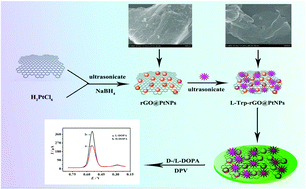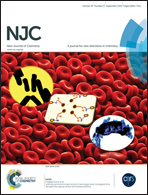The application of l-tryptophan functionalized graphene-supported platinum nanoparticles for chiral recognition of DOPA enantiomers
Abstract
A new nanocomposite of L-tryptophan functionalized graphene-supported platinum nanoparticles (L-Trp-rGO@PtNPs) was synthesized utilizing a facile ultrasonic method via π–π conjugate action between graphene-supported platinum nanoparticles and L-tryptophan (L-Trp) molecules. The prepared nanomaterial, which dispersed well in water and presented excellent conductivity, was modified on a glassy carbon electrode (L-Trp-rGO@PtNPs/GCE) for the chiral sensing of DOPA enantiomers. The immobilization process of L-Trp-rGO@PtNPs/GCE was characterized by cyclic voltammetry, electrochemical impedance spectroscopy, scanning electron microscopy, ultraviolet-visible (UV-vis) spectrometry and Raman spectroscopy. The electrochemical reactions of DOPA enantiomers were investigated via differential pulse voltammetry. The proposed electrochemical method showed excellent enantiospecificity for DOPA enantiomers and exhibited a stronger enantiospecificity for D-DOPA. In addition, the experimental parameters such as the concentration, the amount of L-Trp-rGO@PtNPs and the pH values were optimized. Under optimum conditions, the linear response ranges for the discrimination of DOPA were from 5.0 × 10−8 to 5.0 × 10−3 mol L−1 with a detection limit of 1.7 × 10−8 mol L−1 (S/N = 3).


 Please wait while we load your content...
Please wait while we load your content...